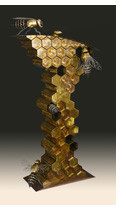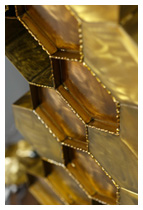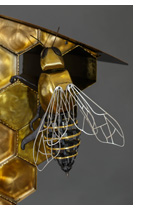Just "Bee-Cause"
![]() Print this Article | Send to Colleague
Print this Article | Send to Colleague
 As a metal artist living on the Eastern Shore of Maryland, I have no shortage of inspiration for new work. My home and studio are located on six acres which were once farm fields. Aside from a modest house and large workshop, the property has given me a blank slate for designing and creating a welcoming landscape. I have set aside two acres as a sculpture garden and enjoy the process of shaping the area, planting trees and shrubs, along with creating sculptures for this site.
As a metal artist living on the Eastern Shore of Maryland, I have no shortage of inspiration for new work. My home and studio are located on six acres which were once farm fields. Aside from a modest house and large workshop, the property has given me a blank slate for designing and creating a welcoming landscape. I have set aside two acres as a sculpture garden and enjoy the process of shaping the area, planting trees and shrubs, along with creating sculptures for this site.The property gives me lots of opportunity to be outside, planting and pruning. I find the time spent doing this to be relaxing. Without consciously doing it, I absorb so much from being outdoors, and it is reflected in my art work. Plus, a good break in the yard will often result in a design solution or resolution to a problem that I didn’t even know I was still thinking about.
My experiences in the gardens had given me a nearly fully formed idea about building a large scale beehive with bees tending to it. Not long after, I was approached by a local gallery to participate in their "Earthwork" show, which was part of an area wide, series of shows and events with the theme Stewardship of the Earth. Here was the perfect opportunity and justification to work on my largest project to date.

The resulting sculpture, titled "Bee-Cause", stands nearly six feet high and is for indoor use only. The honey comb is made with cold rolled, mild, 18 gauge steel. Each hexagon was made of six equally sheared pieces that were welded in a fixture to create a tube. The tubes were then assembled and welded to create the main structure. The curved top and base are intended to soften and add interest to the sculpture. I used Sculpt Nouveau metal stains and lacquers on the entire piece and I love the various honey colors achieved in the honey comb ends.
The BEES are magnificent. They are also made of cold rolled steel with the head and main body being hollow forms. Flat steel was hammered into lead blocks to create sections that were welded together. The wings and tail sections were plasma cut, and the tail section was bent into shape and wrapped with brass wire. The legs were my first forging project, and although not fancy, the effect works well. Each bee measures 12 inches long.

The design came together very quickly. The sticking point was how to resolve the bee’s tail end. I wanted to create a sense of a light, hairy body with perpendicular lines to the main body, while mimicking the rings or stripes they appear to have. I think the negative space and brass wire accomplished that goal.
This sculpture was a real break out piece for me. It took two months to complete and had several challenges in its construction. During the process, I realized with all the details in the piece it would be best suited to indoor use only. I learned a lot from the process, and it gave me confidence to push ahead with larger sculptural work that I want to explore. It has been shown in several shows and has been very well received. Although it is still waiting for its ultimate home, I think the bees may have their own fan club.
For more information see robglebedesign.com
Photo credit for Bee-Cause sculpture: Steven Buchanan
